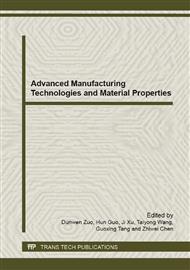[1]
Y. Altintas, E. Budak, Analytical prediction of stability lobes in Milling, CIRP Annals- Manufacturing technology: (1995).
DOI: 10.1016/s0007-8506(07)62342-7
Google Scholar
[2]
U. Bravo, O. Altuzarra, D. L. López, J.A. Sánchez, Campa, F. J, Stability limits of milling considering the flexibility of workpiece and the machine, International Journal of machine tools and manufacture, 45(2005)1669-1680.
DOI: 10.1016/j.ijmachtools.2005.03.004
Google Scholar
[3]
O.B. Adetoro, W.M. Sim , P.H. Wen, An improved prediction of stability lobes using nonlinear thin wall dynamics, Journal of Material Processing Technology 210(2010) 969-979.
DOI: 10.1016/j.jmatprotec.2010.02.009
Google Scholar
[4]
O.B. Adetoro, P.H. Wen, W.M. Sim, R. Vepa, Numerical and Experimental Investigation for Stability Lobes Prediction in Thin Wall Machining, Engineering Letters, (2009).
Google Scholar
[5]
S. -J. Kim, H.U. Lee, D. -W. Cho, Prediction of chatter in NC machining based on a dynamic cutting force model for ball end milling, International Journal of Machine Tools & Manufacture, 47(2007)1827-1838.
DOI: 10.1016/j.ijmachtools.2007.04.005
Google Scholar
[6]
M. Zatarain, I. Bediaga, J. Muñoa, T. Insperger, Analysis of directional factors in milling: importance of multi-frequency calculation and of the inclusion of the effect of the helix angle, International Journal of Advance Manufacturing Technology, 47(2010).
DOI: 10.1007/s00170-009-2230-5
Google Scholar
[7]
A.J. Tang, Z.Q. Liu, Effect of helix angle and normal rake angle on stability in end milling, Advanced Materials Research (2009)69-70.
DOI: 10.4028/www.scientific.net/amr.69-70.394
Google Scholar
[8]
A.J. Tang, Z.Q. Liu, , Three-dimensional stability lobe and maximum material removal rate in end milling of thin-walled plate, International Journal of Advanced Manufacturing Technology, 43(2009) 33–39.
DOI: 10.1007/s00170-008-1695-y
Google Scholar
[9]
S. P Nhleko, Free Vibration Stability of SDoF Systems Undergoing Variable mass-induced Damping, IMAC-XXVII, (2009).
Google Scholar


